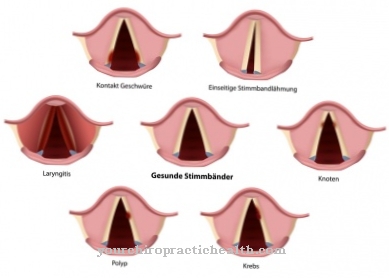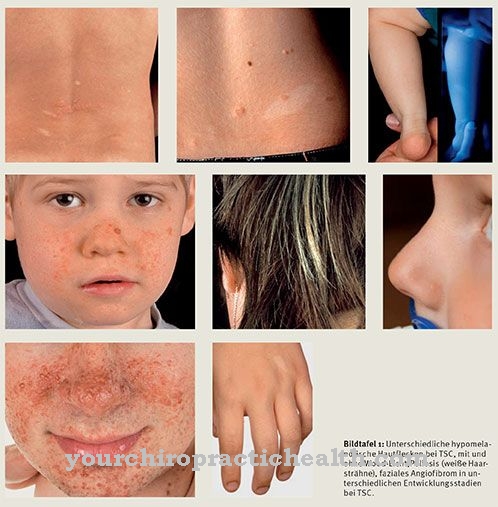Nephronophthisis are kidney diseases that result from a genetic mutation or deletion. Terminal kidney failure occurs in these seven forms of disease by the age of 25 at the latest. So far, the only curative therapy available is a transplant.
What are nephronophthisis?

© Rasi - stock.adobe.com
At Nephronophthisis are genetic kidney diseases with chronic inflammatory properties. The interstitial kidney tissue is the main target of diseases. So far, seven different hereditary diseases have been assigned to this group:
- juvenile nephronophthisis
- infantile nephronophthisis
- adolescent nephronophthisis
The remaining three diseases are referred to as NPHP4, NPHP5, NPHP6 and NPHP7 and have so far not been well researched.
Until the 1970s, researchers described nephronophthisis as medullary cystic kidney disease. These diseases can hardly be differentiated from one another histologically. The inheritance of medullary cystic kidney diseases differs from the inheritance of nephronophthises. Instead of an autosomal dominant inheritance, the nephrophthisis have an autosomal recessive inheritance. The frequency of all forms is given with a ratio of about 1: 100,000.
causes
The cause of all nephronophthisas is a gene mutation or gene deletion. The diseases are therefore genetic and inherited in an autosomal recessive manner. In juvenile nephronophthisis, the mutated gene is located on chromosome 2 gene locus q13. This gene codes for the protein nephrocystin-1. When mutated or deleted, the protein loses its function. Infantile nephronophthisis, on the other hand, is associated with a mutation or deletion on chromosome 9 gene locus q22-q31, which codes for the protein inversin.
In the adolescent form, the genetic defect is on chromosome 3 gene locus q21-q22. The fourth form of nephronophthisis is caused by a mutation or deletion on chromosome 1 gene locus p36.22, where the protein nephroretinin is coded for. The fifth variant is a deletion or mutation on chromosome 3 gene locus q21.1 that affects the protein nephrocystin-5. NPHP6 was attributed to an abnormality on chromosome 12 gene locus q21.33 and in NPHP7 the zinc finger protein is impaired.
Symptoms, ailments & signs
With all nephronophthises, enormous salt losses occur, which dehydrate the patient considerably and usually trigger a shift in the electrolyte balance. The urine can no longer be brought to a concentration of 800 mosm * kg − 1H2O. Azotemia occurs. Those affected have an above-average content of nitrogenous metabolic products in their blood.
Anemia or anemia are also symptoms of nephronophthisis. In addition, there is hypokalaemia, i.e. a lack of potassium. Acidification is just as common. The tubules of the kidneys are atrophic and expand cystically. In contrast to healthy patients, the tubules lie on the corticomedullary borderline.
Cysts form mainly on the collecting ducts of the renal medulla and on the distal convolute of the kidneys. The kidney function decreases step by step and leads to terminal kidney failure. Terminal kidney failure only occurs after the age of majority in adolescent nephronophthisis.
Diagnosis & course of disease
The doctor usually makes the diagnosis of nephronophthisis using blood tests, urine samples and kidney function scintigraphy, as well as imaging procedures. Both ultrasound and MRI can be used as imaging. As a rule, nephronophthisis remain undetected for a long time until severe symptoms develop.
The prognosis for those affected is rather poor. End-stage kidney failure occurs in all patients by the age of 25 at the latest. The adolescent form is associated with the comparatively most favorable prognoses, since kidney failure in this subspecies is not to be expected until after the age of majority.
Complications
Complications always occur in patients with nephronophthisis. All genetic defects sooner or later lead to kidney failure. However, the time at which terminal kidney failure occurs depends on which genetic defect is involved. Thereafter, life can be maintained with the help of dialysis until a kidney transplant.
In the most common genetic defect, the NPHP1 defect, terminal kidney failure occurs before the age of 25. It can occur at any time during this period. With the help of symptomatic treatment, the onset of kidney failure could be postponed. The prognosis for the NPHP2 defect is even less favorable. Terminal kidney failure often occurs before birth, but at the latest within the first year of life.
The course of the NPHP3 defect is somewhat more favorable. Terminal kidney failure usually only takes place around the age of 19. Not much is known about the genetic defects NPHP4, NPHP5, NPHP6, and NPHP7. However, kidney failure occurs here as well.
The patient requires constant medical treatment and monitoring, as otherwise there will be an accumulation of urinary substances in the blood, a potassium deficiency, anemia (anemia) and metabolic acidosis (hyperacidity). Despite constant blood purification, a total failure of the kidneys can occur, a life-threatening condition that can only be remedied with a kidney transplant.
When should you go to the doctor?
When to see a doctor with nephronophthisis depends, among other things, on the type of disease and its severity. Basically, kidney problems should be clarified if they persist for more than a few weeks. Signs of anemia and deficiency symptoms require medical clarification. A doctor must also be consulted in the event of hormonal complaints or kidney pain. Anyone who already suffers from kidney disease should report the symptoms to the doctor.Medical advice is also required if an existing illness suddenly becomes worse or if you experience unusual symptoms that were previously not noticed.
The doctor will then perform a comprehensive examination and use it to make a diagnosis. If this is done early, serious complications can be avoided. Therefore, the first signs must be clarified and treated if necessary. The right contact person is the family doctor, an internist or a nephrologist. In the event of severe complaints, the person affected should be taken to hospital immediately. A visit to a specialist clinic for kidney disease may also be necessary.
Treatment & Therapy
There is no causal therapy for patients with nephronophthisis. Treatment is limited to symptom relief. The progressive renal insufficiency cannot be stopped with the current therapy options. The only prospect of complete cure is a kidney transplant. In more than ten percent of all those affected, the diagnosis is only made when terminal kidney failure is already present.
Several treatment options are available as renal replacement therapies after the onset of terminal kidney failure. The dialysis options are hemodialysis and peritoneal dialysis. All dialysis procedures are blood purification procedures that are intended to replace the blood-purifying and detoxifying functions of the kidneys. Hemodialysis is an extracorporeal procedure and takes place outside of your own body.
Peritoneal dialysis, on the other hand, is an intracorporeal procedure and is used within the patient's body. The former is much more commonly used as renal replacement therapy. In the long run, dialysis cannot replace a functioning kidney. Therefore, sooner or later, end-stage kidney failure will always require a kidney transplant. This can either be a relatives kidney transplant or a deceased kidney transplant.
Suitable donor kidneys are currently being found more often than ever before, because transplant lists are no longer limited to Germany, but refer to the entire EU. Research is also currently focused on developing drug therapies for patients with nephronophthisis. In the foreseeable future, it may be possible to delay the progressive kidney failure with medication.
Outlook & forecast
In general, the prognosis for all those affected is rather unfavorable. With all forms of the disease, terminal renal failure usually develops by the age of 25 at the latest. The occurrence of this ultimate kidney failure depends on the genetic defect present. With an NPHP1 defect, the kidneys usually fail before the age of 25. The prognosis is less favorable in the presence of an NPHP2 defect. In this case, the kidneys usually lose their functionality before birth or during the first year of life. With an NPHP3 defect, kidney failure begins on average around the age of 19. To date, insufficiently meaningful study data are available for the genetic defects NPHP3 to NPHP7, so that the specialists are unable to make a more precise prognosis with regard to the timing of the kidney failure.
Terminal kidney failure, however, is not a death sentence. The function of the kidneys can be replaced by dialysis until the specialists can transplant a suitable donor organ. However, the waiting time before receiving a donor kidney can be very long because too few donor kidneys are available. Despite dialysis, kidney failure affects the body. The accumulation of urinary substances often results in increased itching and yellowing of the skin. If left untreated, nephronophthisis lead to terminal renal insufficiency that sets in much earlier.
prevention
Since nephronophthisis are mutation-related hereditary diseases, the diseases can hardly be prevented.
Aftercare
The symptomatic treatment of nephronophthisis via a kidney transplant means for the patient the usual follow-up care after an organ transplant. In inpatient treatment, in addition to wound care after the procedure, there is also drug treatment. In order for the new kidney to be accepted by its own body, the organ recipient must take immunosuppressants for life.
A rehabilitation phase follows the inpatient stay. The subsequent outpatient follow-up includes checking the blood values at weekly intervals at the beginning, but at least every quarter. This is used to check whether the kidneys are working and performing well. A radiological examination using ultrasound, CT or MRT enables the kidney to be examined. These follow-up exams are important to see if the kidney is being rejected by the body or if the organ is inflamed.
If those affected are treated with dialysis because no suitable donor organ has been found, hygienic regulations must be observed. Only in this way can dialysis, which is carried out via a so-called shunt (an arteriovenous fistula), proceed without complications. After the blood cleanse, patients are advised to watch their diet between regular hemodialysis sessions. The intake of potassium, phosphates and salt must be kept low. Protein, on the other hand, should be ingested in sufficient quantities through food.
You can do that yourself
If a nephronophthisis has been diagnosed, the person concerned must first seek medical treatment. A variety of dietary measures can then be taken to alleviate the symptoms and symptoms of the condition.
First and foremost, it is important to have a gentle diet, which can include raw vegetables, low-salt foods, fruit juices and mineral water. The nutrition plan should be drawn up together with a nutritionist so that the kidneys can optimally adjust to it. If complications arise, the doctor must be informed. If kidney failure is suspected, it is best to call the emergency services. If kidney pain suddenly occurs, the doctor must be activated. Cyst kidneys may have formed, which require medical treatment.
The sick should also ensure sufficient exercise. Moderate exercise, which minimizes stress on the kidneys, helps recovery by strengthening the immune system and promoting digestion. Since it is a hereditary disease, those affected should have the necessary genetic tests carried out during pregnancy. Genetic counseling provides information about the risks.

.jpg)






















.jpg)



